Disclosure: Some posts contain affiliate links, which earn us a commission if you make a purchase through them. Positive Fishing © participates in various affiliate networks including the Amazon Services LLC Associates Program.
If you’re new to fishing then understanding all the different types of fishing reels is no easy task. There are so many individual options to choose from, but fortunately, there are only 5 major reel types.
In this article, we are going to focus on all the types of fishing reels and run through their pros, cons, difficulty, and when it is best to use them.
By the end of the article, you should be able to pick the right reel for your needs for every fishing situation you find yourself in.
What Are The 5 Main Types Of Fishing Reels?
The most popular type of reels used by anglers are:
- Spincast Reels
- Spinning Reels
- Baitcasting Reels
- Trolling Reels
- Fly Reels
Spincast Reels
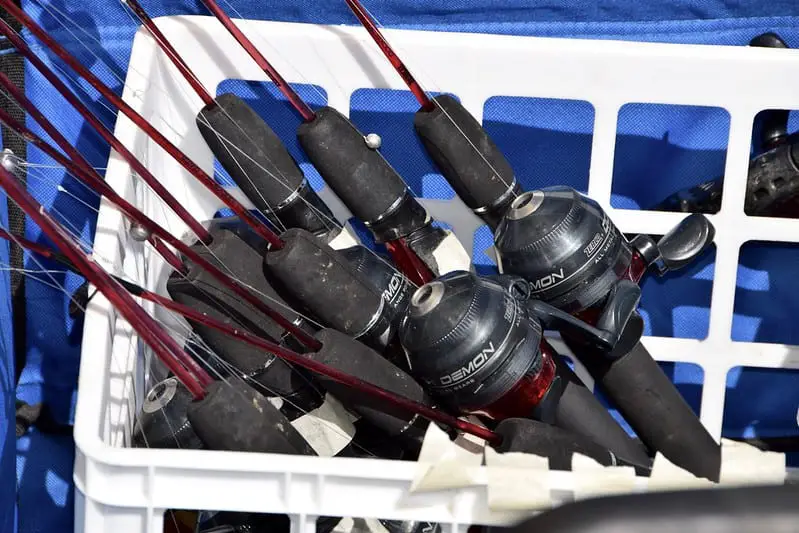
Spincast reels are one of the easiest types of fishing reels to use and are the perfect choice for anyone who is new to fishing but wants to get started.
These reels come with a nose cone that covers the spool of the reel (where the line goes) and features a button that releases the spool into free spool mode when pressed and locks the spool into drag mode when released.
Spincast reels also come with an adjustable drag system which allows you to tweak how much pressure a fish feels when trying to pull the line off from your reel. You can usually find the drag mechanism on the side of the reel or by the handle.
Ease Of Use
Spincast reels are particularly easy to use as to cast your lure out all you need to do is swing your rod back, press and hold the spool release button, and make your forward cast. Once your lure or bait lands, simply release the button and start fishing.
The nose cone also serves well in stopping any tangles by ensuring the line leaves the spool in a uniform manner, hence why they are a great type of reel for beginners and young anglers to use.
What’s Good & Bad?
Aside from being super easy to use and almost tangle-free, spin cast reels are also incredibly affordable making them an excellent choice to start your fishing career with. Most anglers started out using spin cast reels and have a nostalgic affection for them.
Spincast reels come in a range of sizes from small to medium, making them great for targeting smaller species like trout but they are not designed to handle bigger fish like salmon or dorado for example.
There are, of course, some downsides to spincast reels. If you do get a tangle, removing it is quite tricky as you will have to get inside the cone and sort it out. Also, the cone tends to hold things like salt, sand, and moisture which quickly degrade a reel.
Spincast reels are not made to the same high standards as other reels and therefore lack durability. You might get a year of consistent use out of one and then you will have to buy a new one again.
Spincast reels also limit your fishing to an extent. Their casting distances and accuracy do not compare to, say, spinning reels, and you are also limited by the size of fish you can target since their drag systems are quite weak.
Overall, they are the perfect reel to get started with but you will want to upgrade to a spinning reel once you have the hang of fishing.
Pros
- Very affordable
- Simple to use
- Great for beginners and young anglers
- Reduce tangles
Cons
- Not so durable
- Limited size range
- Limited casting distance
- Tangles are a pain when they happen
Spinning Reels
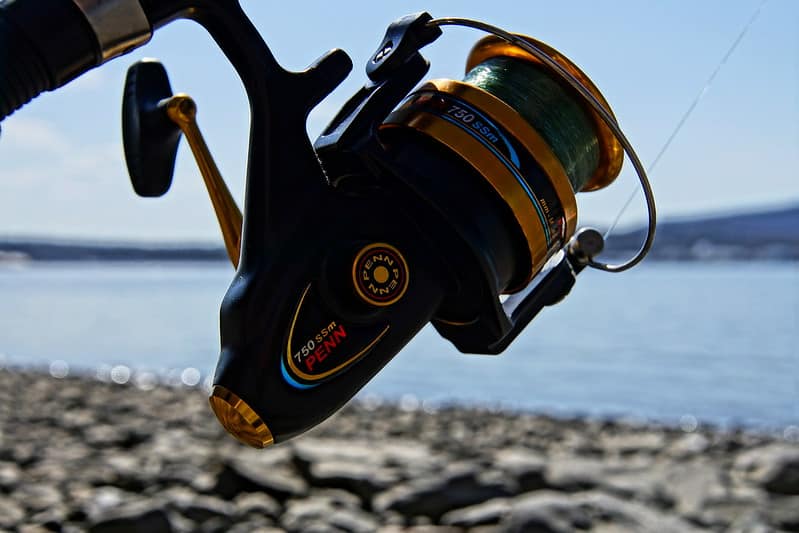
Spinning reels are one of the most popular and versatile types of fishing reels on the planet. They come in a huge range of sizes that match every species from tiny trout to massive marlin, plus they are easy to use too!
Spinning reels look a bit like a spincast reel but there is no nose cone meaning the spool is open and exposed. Around the line spool is a bail arm that holds the line in place and stops it from running freely, and this also guides the line onto the spool when you wind it in.
Spinning reels also come with a drag mechanism which is usually adjusted from the top and some sizes can push out a huge amount of drag meaning they are ready for some really big fish.
Ease Of Use
Spinning reels are almost as easy to use as spincast reels. To cast with a spinning reel all you need to do is hold the line against the rod with your index finger, open the bail arm, move the rod behind you to load with energy, and then push it forward releasing the line as the rod comes past your ear on the forward cast.
Your bait or lure will end up going exactly when you point your rod tip and once it has landed, simply close the bail arm and wind the handle to bring your line in. If you forget to close the bail arm, you may find that your line is wound around the reel base instead of the spool causing a tangle, so be sure not to forget.
What’s Good & Bad?
As I mentioned in the beginning, spinning reels are incredibly versatile and you can find one to match every species on the planet and pretty much every budget too!
You can buy a good spinning reel for $80 and they go all the way up to close to $1000 for those of you who need the strongest spinning reel to land a fish like a marlin.
Also, when combined with braid, the casting distances and casting accuracy one can achieve with a spinning reel are hard to beat. Plus, you get all of these great pros on an easy-to-use reel that anyone can get the hang of in a day of practice.
A good spinning reel is also durable (price does equal quality here) which means it will be with you for many years to come so long as you look after it.
The only downside is that if you don’t use them correctly, tangles can become an issue but these are rare once you have the hang of it.
Pros
- Incredibly versatile
- A size for every species
- There is one for every budget
- Great casting distances and accuracy
- Simple and easy to use
- Good quality and durability
- Simple to maintain
Cons
- Tangles can happen when not used correctly
One variation of the spinning reel is the baitrunner reel, which has an option with a second drag system. The drag setting can also be set to allow fish to “run” with the bait, this is especially useful for carp fishing and pike and other large predator fishing. The best bait runners on the market are the Shimano range.
Baitcasting Reels
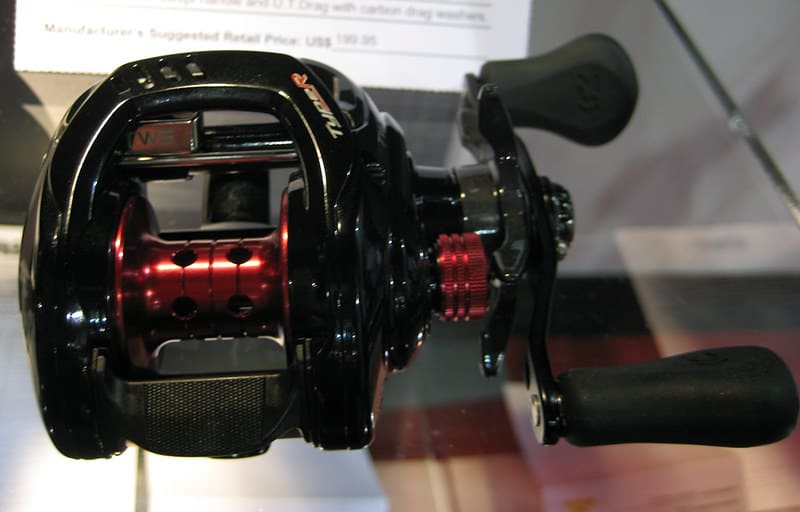
Baitcasting reels are one of the hardest types of reels to use and are usually used by pro anglers who have mastered spinning reels but want more performance.
Baitcasting reels, also known as baitcasters, sit on the top of the rod and come with a lot more features than a spinning reel which makes them harder to master. The spool is open, they have a drag system, plus a spool tension knob and a brake adjustment system that is used for casting.
Ease Of Use
It takes some time to master casting with a baitcaster but the rewards are pinpoint casting accuracy and longer casting distances.
To cast with a baitcaster you first have to adjust the spool tension and braking system to the right levels. The idea here is to create enough spool tension so the line casts as far as you want it but without it being too loose and causing a backlash (aka a huge bird’s nest tangle).
The trickiness doesn’t stop there though as you will also have to add more tension to the spool using your thumb when casting.
First, adjust your spool tension and braking system, then throw your cast with your thumb on the spool adjusting tension as the line goes out. The idea is to cast as far as you can without getting tangled and it is all about feel and getting to know your reel, so it does take some practice and a few tangles to get right.
What’s Good & Bad?
Baitcasters provide the best casting performance of all types of reels, once you get the hang of them. This means you can drop your lure exactly next to a brush pile when looking for bass, for example.
These reels also come in a range of sizes and have excellent pulling power and can stop some serious fish if you want to target larger species.
The downside to baitcasters is how hard they are to use, and even once you get the hang of them, you will still need to adjust the spool tension for every different weight of the lure to find the best casting performance.
Baitcasters are also more expensive than both spincast and spinning reels. You should expect to pay around $150 for a quality one!
Pros
- Awesome casting distances
- Pinpoint casting accuracy
- Greater pulling power
- Lots of sizes to choose from
- Durable and long-lasting
Cons
- Hard to learn how to use
- Tangles are common in the early days
- A more expensive option
Trolling Reels
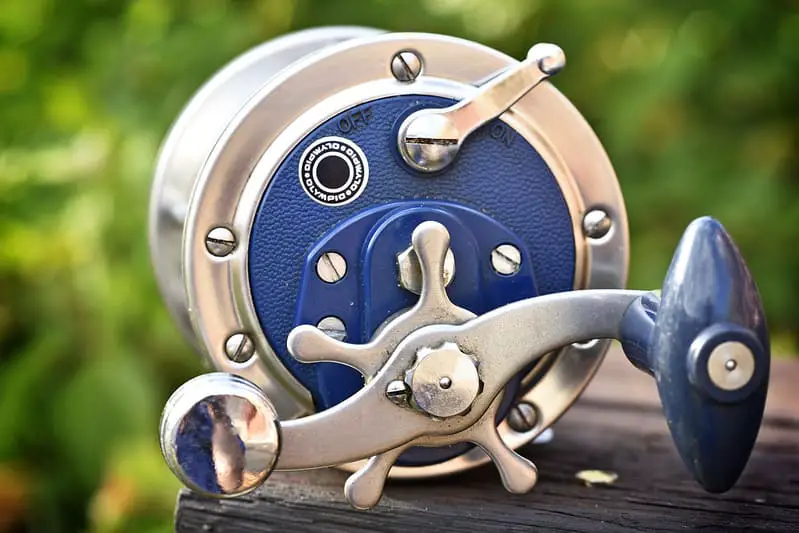
Trolling reels look a little bit like baitcasters but they are not designed for casting, they are made to be used for trolling – pulling lures behind a moving boat. You can also use them for bottom fishing too though, as no casting is required.
Trolling reels come in a huge range of sizes from small 10lb class reels all the way up to 130lb class reels. This means you can use them for everything from bottom fish for small snappers all the way up to landing a 1000lb blue marlin.
Trolling reels come with a lever or star drag system on the side which is highly adjustable, the spool is open, and they have a ratchet (noise maker), that you can turn on and off. The ratchet signals when a fish is taking a line and it also provides some spool pressure to stop tangles from happening.
Ease Of Use
Trolling reels are very simple to use as you are either letting them out the back of a moving boat or dropping the line to the bottom. To use them, you hold your thumb on the spool and release the drag lever to zero.
The lead weight on your line will pull your bait down into the sea and all you need to do is let the line out to the desired length while continuing to thumb the line to stop any tangles. You can also use the ratchet to stop any tangles but it can be quite noisy.
Once your lure is the desired distance behind the boat or has hit the bottom, simply adjust the drag lever to your desired tension to match the pound line on the reel and turn the ratchet on. Simple!
What’s Good & Bad?
Trolling reels are incredibly reliable and great at what they are made for, trolling and bottom fishing, plus they are very simple to use too!
You can also find them in a large range of sizes to match almost all size species and since they are built for predominantly saltwater use, they are very durable too.
The downsides are their lack of versatility and chances are if you are going to own a trolling reel, you will have to own a boat too in order to use them. Also, a good trolling reel can be between $350 to over $1000, so they can be very expensive.
Pros
- A size to match all species
- Great for trolling and bottom fishing
- Highly adjustable drag
- Super durable
- Simple to use
Cons
- Not very versatile
- Can be expensive
Fly Reels
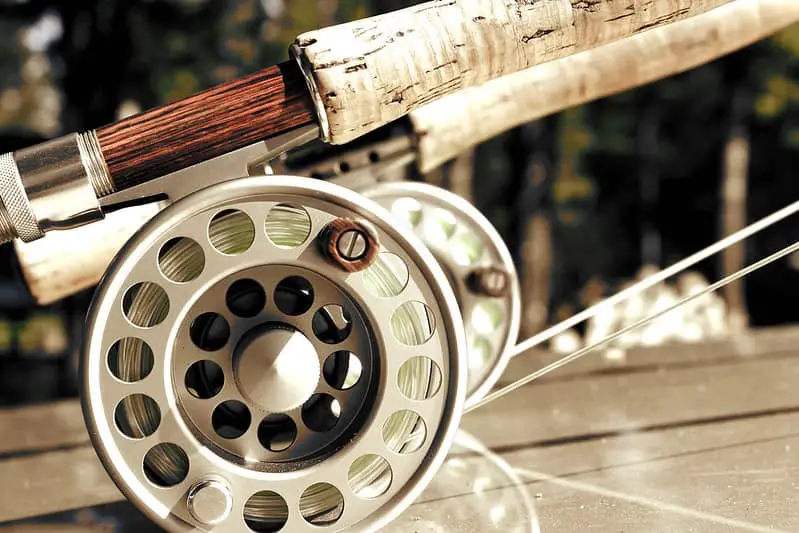
Fly reels are exclusively designed for use with a fly rod when fly fishing. They are round reels with a handle on one side and a drag system on the other. They can also come with no drag depending on the size of the fly reel.
When fly fishing for smaller species like 2lb trout, a good intermediate fly reel can be used more as a line holder than anything else, as you will fight the fish using the rod and controlling line tension with your hand.
But, once you start targeting large species like bonefish, for example, your fly reel plays a very important role. A bonefish swims at over 30 mph and therefore once you hook one, you will have to clear your loose fly line and get the fish onto the reel when the drag system ensures you can land it.
Ease Of Use
Fly reels are very simple to use, but fly fishing isn’t so simple. Once you have mastered your casting, all you need to do with the reel is set the right drag tension for the fish you are targeting by simply turning the adjustment knob on the side.
Once you hook a fish, you just need to get the excess line onto the reel or let the fish take it, to then be able to use the drag and play the fish off the reel. You can also adjust the drag tension mid-fight to match the situation if you need to.
Unlike most reel types, a fly reel has nothing to do with casting, as to cast you just need to pull enough line off the reel and leave it by your feet to make the cast.
What’s Good & Bad?
The great thing about a fly reel is how easy it is to use, but the bad thing is you will need to have mastered fly fishing to use it, which is the hard part.
Fly reels come in a range of weights (sizes) to catch every species in the world from small brook trout to 100lb+ tarpon, so they are very versatile! Tangles caused by the reel are virtually non-existent too.
The main downside of a fly reel is that a good one can be expensive, especially if you want one that can handle the likes of big saltwater species like tarpon. In this case, you would want to use a top of the range saltwater fly reel.
Pros
- Easy to use
- Almost tangle free
- A weight for every species
- Great drag systems (on some)
Cons
- Learning to fly fish isn’t easy
- Can be expensive
How To Choose The Right Type Of Reel?
Selecting which one out of the five reel choices you should use can be narrowed down based on a few basic questions:
- Where are you going to fish?
- What type of fish are you targeting?
- How big are the fish?
- How experienced are you at fishing?
- What Is Your budget?
Where Are You Going To Fish?
Saltwater/ Ocean – Choose a spinning, baitcasting, or trolling reel.
Rivers/Lakes – Choose a spincast, spinning, or fly reel
What Type Of Fish Are You Targetting?
General freshwater fish – Spincast, spinning
Large saltwater fish – Baitcasting or trolling
Game fish (Trout, salmon, grayling) – Spinning or fly reel
How Big Are The Fish?
Small – Spincast, spinning, or fly reel
Large – Spinning, baitcasting, trolling, or fly reel
How Experienced Are You At Fishing?
Beginner – Spincast or spinning reel
Expert – Spinning, baitcasting, trolling, or fly reel
What Is Your Budget?
Low – Spincast or spinning reel
High – Spinning, baitcasting, trolling, or fly reel
As you can see there is some crossover of options, but as a general guide this will cut down some of the confusion. In the majority of scenarios, the spinning reel will always be the most versatile option and also meet both cost options.
Winding Up
Thanks very much for reading my article. I hope you found it useful and now have a better understanding of the types of fishing reels and when to use each one.
Spinning reels are by far the most versatile reels while being easy to use, so I recommend using them over all the others unless you are planning to fish frequently in a more unique style such as trolling or fly fishing.
Now you know all the types of fishing reels, why not check out my article on all the types of fishing rods here!
- 5 Best Fishing Bags For Getting Your Gear Organized - January 13, 2025
- 4 Essential Surf Fishing Rigs - January 11, 2025
- How To Know The Sex Of A Fish You Have Caught? - December 9, 2024

